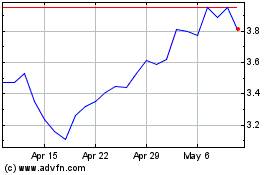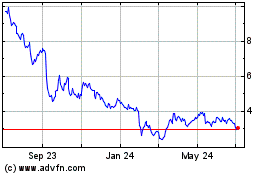Despite Crude Oil Price Decline, Global Upstream M&A Transaction Value Rose in 2014, IHS Says
January 05 2015 - 5:00AM
Business Wire
Overall deal count plummeted during final two months of 2014
despite solid activity beforehand; Repsol’s announced takeover of
Talisman may signal further consolidation
Despite a late-year plunge in crude oil prices, robust merger
and acquisition activity (M&A) in the first 10 months of the
year fueled an increase in the total transaction value for global
upstream oil and gas M&A deals in 2014, which rose 23 percent
to $173 billion, according to analysis from information and insight
provider IHS (NYSE: IHS).
This rebound in 2014 transaction value is particularly
noteworthy for the industry after transaction value for global
upstream oil and gas M&A deals fell by almost half during 2013
to $140 billion, the lowest level since the 2008 recession. In
2013, rather than shopping for deals, oil and gas companies shifted
their focus to developing their vast inventories of previously
acquired reserves, resources and acreage.
“The uncertainty caused by the severe decline in oil prices
during the final two months of 2014 nearly brought deal activity to
a standstill,” said Christopher Sheehan, director of energy M&A
research at IHS. “Buyers and sellers are having difficulty reaching
a consensus because of the oil price tumble, which is causing
significant uncertainty for the industry. However, transformative
acquisition opportunities typically arise at the bottom of the
crude price cycle, so Repsol’s late-year agreement to acquire
Talisman Energy may be the tip of the iceberg for corporate
consolidation if crude prices remain depressed throughout 2015. The
deal may foreshadow further consolidation in the oil and gas
industry.”
Another significant change in 2014 upstream M&A activity was
a plunge in acquisitions by Asian and Caspian regional national oil
companies (NOCs). Asian and Caspian regional NOCs were buyers in
half of the 10 largest deals in 2013, but none of these companies
were buyers in the 10 largest deals in 2014. Seven of the 10
largest worldwide deals involved North American-based E&Ps as
either buyer or seller in transactions that each exceeded $2
billion.
The value of overseas acquisitions by Chinese NOCs fell steeply
in 2014 to less than $3 billion from $20 billion in 2013. However,
private Chinese financial and industrial conglomerates emerged as
more active buyers in the global M&A market. And the Chinese
NOCs reached large, forward-sale oil and gas supply agreements
worth tens of billions of dollars with Russia, highlighting the
strengthening of ties between Asian NOCs and Russia as sanctions
reduce western investment. Western integrated oil companies, such
as Royal Dutch Shell, which divested approximately $15 billion in
worldwide upstream assets in 2014, were among the most active
global market sellers during the year. Meanwhile, Middle Eastern
NOCs increased their overseas acquisition spending.
According to IHS energy M&A research, worldwide deal count
(which includes both asset deals and corporate deals) rose 4
percent in 2014, but remained well below the 10-year high in 2012.
The number of worldwide asset transactions climbed by 4 percent in
2014, reversing the almost 10 percent decline in the prior year,
noted IHS.
The corporate deal count rose only marginally from the 10-year
low in 2013. Large-scale corporate consolidation was relatively
absent for the second consecutive year, with only three corporate
transactions above $5 billion in 2014, including Repsol’s $15.5
billion takeover agreement for Talisman. Global spending on
unconventional assets in 2014 increased substantially to more than
$70 billion, after plunging by nearly 50 percent in 2013 to
approximately $45 billion. However, this total was almost 20
percent below the peak of $85 billion in 2012.
The United States represented nearly 50 percent of global
upstream oil and gas transaction value in 2014. Four of the
top-five largest U.S. deals targeted unconventional resources, led
by Encana’s $7.8 billion acquisition of Midland Basin private
producer, Athlon Energy. Total U.S. transaction value rose strongly
from the five-year low in 2013, with corporate deal value nearly
quadrupling from a 10-year low, while asset deal value increased by
one-third.
For the second consecutive year, the majority of U.S. deal value
was from transactions in the Mid-Continent (29 percent), onshore
Gulf Coast (16 percent), and Rocky Mountain (22 percent) regions.
Deal activity continued to be modest in the Gulf Mexico, with its
U.S. market share falling to 7 percent in 2014, from 12 percent in
2013. The percentage of U.S. deal value represented by Appalachia,
predominantly in the Marcellus and Utica shales, more than doubled
year-over-year, to 16 percent. Only three of the 10 largest U.S.
deals targeted conventional resources.
IHS found that North America accounted for approximately 60
percent of global upstream deal value in 2014, up from 42 percent
in 2013. Canada’s market share climbed from 7 percent to 13
percent, highlighted by Talisman’s portion of Canadian assets and
Devon Energy’s $2.85 billion sale of conventional, gas-weighted
reserves to Canadian Natural Resources.
Said Sheehan, "Bargain hunters taking advantage of low implied
values for North American gas asset-divestment packages drove a
significant increase in the natural gas weighting of acquired North
American proved (1P) reserves in 2014, following a 10-year low in
2013. Deals outside North America for proved plus probable (2P)
reserves were more than 60 percent oil and liquids for the third
consecutive year.”
Transactions outside North America dominated the top-20 largest
global deals in 2013, but accounted for slightly less than half of
the top 20 in 2014. The Russia and Caspian regions, impacted
considerably by western sanctions, represented only 5 percent of
global market share in 2014, after comprising approximately 25
percent the prior year. The percentage of global deal value more
than doubled in the Asia-Pacific region, while it held steady in
Europe and South and Central America, but declined sharply in the
Africa and Middle East regions due to heightened political
instability.
“Our IHS analysis of upstream companies indicates debt-laden oil
and gas companies that are not well-hedged could increasingly
become takeover targets in 2015,” Sheehan said. “The volume of
global assets for sale could surge if oil prices continue to remain
depressed during the first half of the year. Our new IHS
Significant Energy Assets on the Market (SEAM) database, which is
available on IHS Connect, is already tracking more than $150
billion of oil and gas property and corporate opportunities and
those opportunities are likely to expand.”
For more information on subscribing to the IHS Energy M&A
Research or the IHS SEAM Database, please contact
sales.energy@ihs.com. To speak with Christopher Sheehan, please
contact melissa.manning@ihs.com or press@ihs.com.
About IHS
(www.ihs.com)
IHS (NYSE: IHS) is the leading source of insight, analytics and
expertise in critical areas that shape today’s business landscape.
Businesses and governments in more than 150 countries around the
globe rely on the comprehensive content, expert independent
analysis and flexible delivery methods of IHS to make high-impact
decisions and develop strategies with speed and confidence. IHS has
been in business since 1959 and became a publicly traded company on
the New York Stock Exchange in 2005. Headquartered in Englewood,
Colorado, USA, IHS is committed to sustainable, profitable growth
and employs about 8,800 people in 32 countries around the
world.
IHS is a registered trademark of IHS Inc. All other company and
product names may be trademarks of their respective owners. © 2015
IHS Inc. All rights reserved.
IHSMelissa Manning, +1 832-458-3840melissa.manning@ihs.comorIHS
Media Relations+1 303-305-8021press@ihs.com
IHS (NYSE:IHS)
Historical Stock Chart
From Mar 2024 to Apr 2024

IHS (NYSE:IHS)
Historical Stock Chart
From Apr 2023 to Apr 2024
